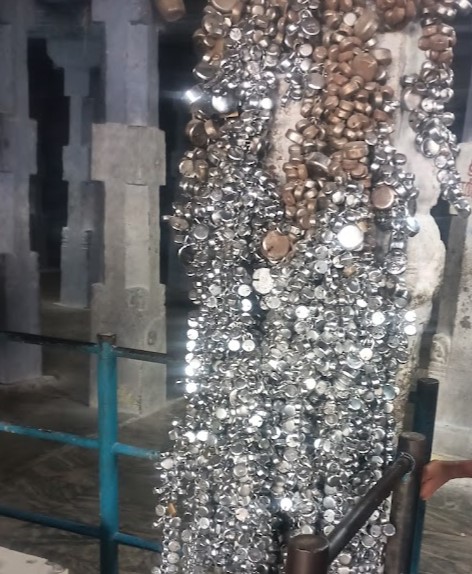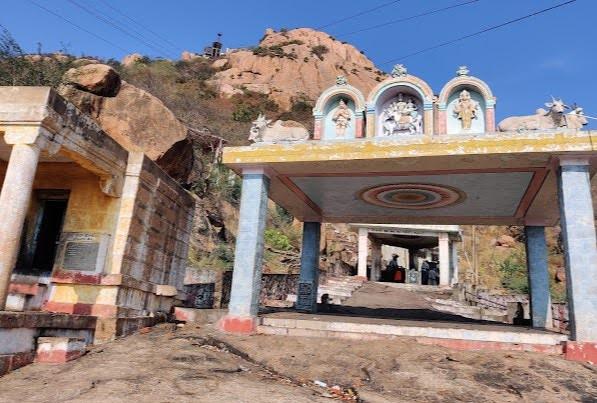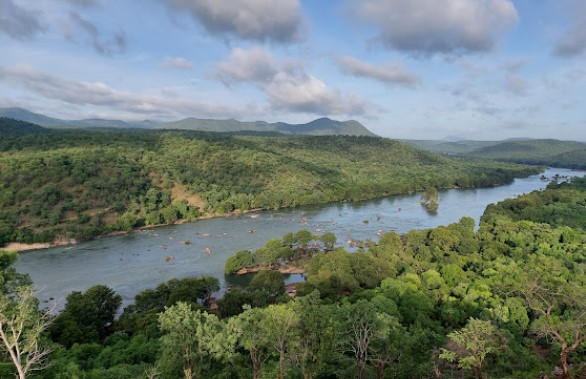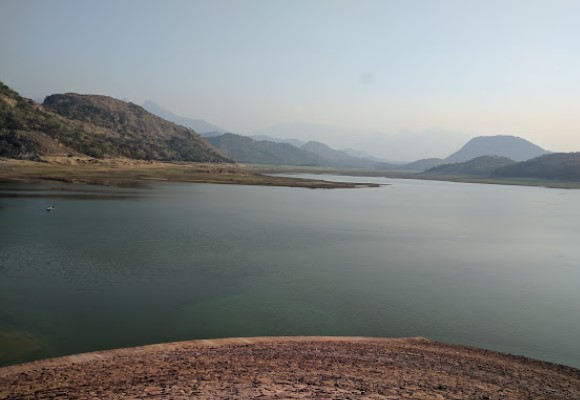- Rathnagiriswarar Temple, dedicated to Lord Shiva, is located at Ayyarmalai near Kulithalai Town in the Karur District of Tamil Nadu.
- The presiding deity is known by various names, including Rathnagiriswarar, Arthanasaleswarar, Manikka Easar, and Raja Lingam, while the goddess is referred to as Karumbar Kuzhali and Aralakesi.
- Perched at an elevation of 342 metres (1178 ft), the temple requires visitors to ascend 1,017 steps to reach its summit.
- The site is known by several names, including Iyer Malai, Rathnagiri, and Thiruvatpokki.
- It is especially auspicious to visit this temple along with Kadambar Kovil in the morning and Thiruveengoimalai in the evening on Mondays during the Tamil month of Karthigai.
- Notably, the temple is believed to be worshipped by lightning every 12 years, adding to its spiritual significance.
- It has been celebrated in the hymns of Saints Tirunavukkarasar and Arunagirinathar, making it the 118th Devaram Padal Petra Shiva Sthalam and the first on the south bank of the Cauvery River in Chozha Nadu.
- Saint Arunagirinathar also composed hymns praising Lord Murugan associated with this temple.
PURANIC SIGNIFICANCE:

Rathnagiriswarar Temple Legends
Origin of Rathnagiriswarar
According to Hindu mythology, a heated argument arose between Adisesha and Vayu regarding their superiority. To resolve this, Lord Indra intervened, proclaiming that Adisesha would carry Mount Meru with his thousand heads, while Vayu would use his strength to tear it apart. Vayu, in his mighty effort, blew Mount Meru apart, causing it to shatter into five parts. Each fragment fell to Earth as a precious gem: Emerald, Ruby, Diamond, Coral, and Sapphire. These sacred lands eventually became significant worship places of Lord Shiva:
- Coral: Thiruvannamalai
- Ruby: Ratnagiri
- Emerald: Engoi Malai
- Blue Sapphire: Pothikai
- Diamond: Kodumudi
Thus, Ratnagiri Hill and the presiding deity, Lord Ratnagirinathar, originated from this divine event.
Slaying of Andakasuran
In another legend, Lord Shiva waged war against the demon Andakasuran. As the demon's blood spilled, fresh replicas emerged. To combat this, Shiva created Yogeswari from the flames of his mouth. The Sapta Kannikas, empowered by the Trimurtis—Skanda, Indra, and Yama—joined forces with Yogeswari to swallow the demon's blood, ultimately leading to the Asura's destruction. Worshipping Yogeswari with the Sapta Kannikas is significant in this temple, with their shrine located inside a cave in the hill.
Indra's Daily Worship
It is believed that Indra worships Lord Shiva here daily through nine holes opposite the Moolavar, manifesting as thunder and lightning. Remarkably, the next day, the garland and vastra of the Moolavar are found burnt, and milk used for abhishekam turns to curd.
The Legend of Thiruvatpokki
According to legend, a king from the north sought gemstones (Rathinam) at this location. Lord Shiva, taking the form of a Brahmin, instructed the king to fill a tub with Cauvery water for a bath. When the king failed, he struck the Brahmin in anger. In response, Lord Shiva appeared, stopped the king's sword (in Tamil, "Vaal" means sword and "pokki" means remove), and granted him a darshan along with the gem. This act led to the place being known as Vaal Pokki (Vaatpokki), and since Shiva provided the Rathinam, he is revered as Rathnagiriswarar. A scar from the sword is still visible on the Lingam today.
Vairagya Perumal's Vow
A devotee named Vairagya Perumal from Kancheepuram vowed to offer his head to Rathnagreeswarar if granted a child. After his wish was fulfilled, he came to the temple and cut off his head, which remained at the foothills while his head ascended to the top of the hill. The idol representing his head is anointed with milk and honey, and the garland offered to the Lord is later placed on this idol.
The Hill of No Crows
An intriguing aspect of the hill is that no crows fly over it. According to tradition, a crow once upset a devotee's milk bowl and was burnt as a result. Since then, crows have not been seen in the area.
Ayvar Malai
The hill is named Ayvar Malai, which translates to "Hill of Five," as it is believed that the five Pandavas briefly stayed here during their exile.
Ponnidum Parai
On the way up the hill is Ponnidum Parai, where Sage Sundarar is said to have received gold from Lord Shiva. It is also believed that Shiva's paadham (foot) is located at this site.
A Place of Meditation
The hill is known for its numerous natural caves, believed to be meditation spots for rishis.
Sage Agastya's Worship
Legend has it that Sage Agastya worshipped Lord Shiva at this temple on his journey to Podhigai.
Snake Bite Belief
A unique belief surrounding the hill is that snake bites from the snakes present here do not harm devotees.
Notable Worshippers
Throughout history, several deities and figures have worshipped Lord Shiva at this site, including Indra, Vayu, Surya, Durga, the Sapta Kannikas, Adi Shesha, Sage Agastya, Sage Romesa, and Jayanthan.
Significance of Thaipusam:
The Thaipoosa Tiruvizha (festival) is celebrated on a grand scale. Rathnagiriswarar & Mother Karumbarkuzhalil give darshan at the banks of the Cauvery along with the idols from the surrounding temples - Pettaivaithalai, Rajendiram, Kulithalai, Thiruengoimalai, Karuppathur, Musiri and Vellur. It is a rare opportunity for the devotees to worship 8 Lord Shiva’s simultaneously.
Mukthi Sthalam:
There is a belief that devotees are assured of Mukthi if they worship Kadambar at this temple in the morning, followed by Ayyarmalai Rathnagiriswarar and Thiruengoimalai Nathar in the evening of the same day.
Cauvery Waters for Pooja:
Lord Shiva of this Temple is lustrated with waters of the Cauvery brought here every day by members of the Aryaraja community. They travel by bike to the Cauvery, eight kilometres away, and then walk back with the filled pot on their head, climb up the hill to empty the water into a large cauldron.
Devadasi Tradition:
The temple was once home to a thriving Devadasi tradition and must have therefore been a venue for much music and dance. This survived till the 1930s or so as is evident from the memoirs of Dr TSS Rajan, the freedom fighter and sometime member of the 1937 Rajaji Ministry.
Miracle of unboiled milk turning to Curd:
The unboiled milk used for abishek does not go stale till the evening though some dust from the incense sticks fall on the milk. Instead, it becomes a good curd the next morning. This is a miracle that could be seen only in this temple.
Devotee Legend
A devotee named Vairagya Perumal from Kancheepuram vowed to offer his head to Rathnagreeswarar if granted a child. Upon fulfilment of his wish, he made the sacrifice; while his feet remained at the foothills, his head reached the temple's summit. This head is anointed with milk and honey, and the garland offered to the Lord is placed on this idol.
ADMINISTRATION:
The Rathnagiriswarar Temple is managed by The Hindu Religious and Charitable Endowments Department of Tamil Nadu.


